Which of the following occurs in meiosis, but not mitosis?
- The cells formed have the same combination of genes as found in the initial cell.
- Sister chromatids undergo disjunction.
- Homologous chromosomes separate.
- A spindle apparatus forms.
- The nuclear envelope disappears.
Homologous chromosomes separate.
Ex.
Homologous chromosomes separate in meiosis, but not mitosis.
A number of key differences between meiosis and mitosis exist. Basically, meiosis reduces the number of chromosome sets from two (diploid) to one (haploid), whereas mitosis conserves the number of chromosome sets. Therefore, meiosis produces cells that differ genetically from their parent cell and from each other, whereas mitosis produces daughter cells that are genetically identical to their parent cell and to each other. In addition, homologous chromosomes separate during anaphase I. This event follows synapsis, an event unique to prophase I.
Remember that independent assortment and crossing over occur during meiosis, producing daughter cells that are genetically unique from the parent cells. The nuclear envelope disappears during both mitosis and meiosis. Sister chromatids undergo disjunction during both mitosis and meiosis. A spindle apparatus forms during both mitosis and meiosis.
What is a locus?
- A type of spore made only by fungi.
- A cell with two chromosome sets.
- A structure that appears during prophase I and consists of two paired genes.
- The precise location of a gene on a chromosome.
The precise location of a gene on a chromosome.
Ex.
The precise location of a gene on a chromosome is called its locus.
Parents endow their offspring with coded information in the form of hereditary units called genes. The genes we inherit from our mothers and fathers are our genetic link to our parents, and they account for family resemblances such as shared eye color or freckles. Our genes program the specific traits that emerge as we develop from fertilized eggs into adults. The location of a gene within the genome, including the identity of the particular chromosome that it maps to and its specific position on that chromosome, is called its locus.
A locus is not a physical structure that appears during prophase I of meiosis nor does it refer to a DNA sequence. The locus is a property of a gene, not a fungal spore. A cell with two chromosomes describes a diploid cell.
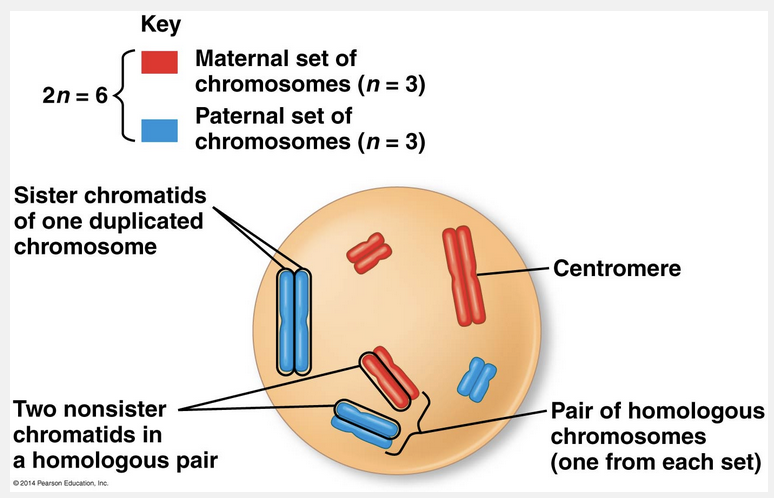
The process called __________ reduces the chromosome number by __________.
- mitosis; destroying one set of information prior to division
- meiosis; two consecutive cell divisions
- mitosis; dividing without chromosome duplication
- mitosis; two consecutive cell divisions
- meiosis; dividing without chromosome duplication
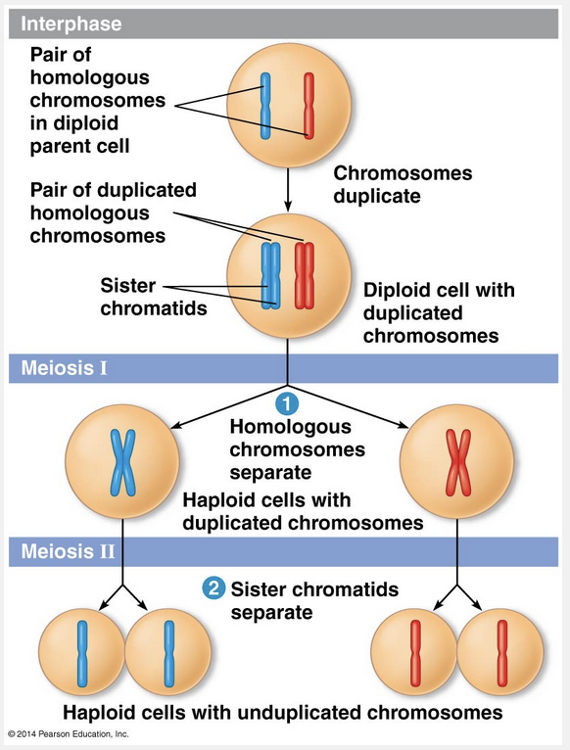
meiosis; two consecutive cell divisions
Ex.
The process called meiosis reduces the chromosome number by two consecutive cell divisions.
Many of the steps of meiosis closely resemble corresponding steps in mitosis. Meiosis, like mitosis, is preceded by the duplication of chromosomes. However, this single duplication is followed by not one but two consecutive cell divisions, called meiosis I and meiosis II. These two divisions result in four daughter cells (rather than the two daughter cells of mitosis), each with only half as many chromosomes as the parent cell—one set, rather than two. The overview of meiosis in this figure shows, for a single pair of homologous chromosomes in a diploid cell, that both members of the pair are duplicated and that the copies are sorted into four haploid daughter cells.
Recall that sister chromatids are two copies of one chromosome that are closely associated all along their lengths; this association is called sister chromatid cohesion. Together, the sister chromatids make up one duplicated chromosome. In contrast, the two chromosomes of a homologous pair are individual chromosomes that were inherited from different parents. Homologs appear alike when viewed under a light microscope, but they may have different versions of genes, each called an allele, at corresponding loci. Homologs are not associated with each other in any obvious way except during meiosis.
“Mitosis; two consecutive cell divisions” is incorrect because mitosis does not reduce the number of chromosome sets that a cell has. “Meiosis; dividing without chromosome duplication” and “mitosis; dividing without chromosome duplication” are incorrect because all cells that undergo meiosis or mitosis must duplicate their chromosomes and form sister chromatids prior to dividing. “Mitosis; destroying one set of information prior to division” is incorrect because mitosis produces two genetically identical cells and no information is destroyed.
Somatic cells in humans contain __________ set(s) of chromosomes and are therefore termed __________.
- two; diploid
- two; haploid
- one; haploid
- three; triploid
- one; diploid
two; diploid
Ex.
Somatic cells in humans contain two sets of chromosomes and are therefore termed diploid.
In humans, each somatic cell has 46 chromosomes. Careful examination of a micrograph of the 46 human chromosomes from a single cell in mitosis reveals that there are two chromosomes of each of 23 types. Any cell with two chromosome sets is called a diploid cell and has a diploid number of chromosomes, abbreviated 2n. Unlike somatic cells, gametes contain a single set of chromosomes. Such cells are called haploid cells, and each has a haploid number of chromosomes (n). Usually, human cells are not triploid.
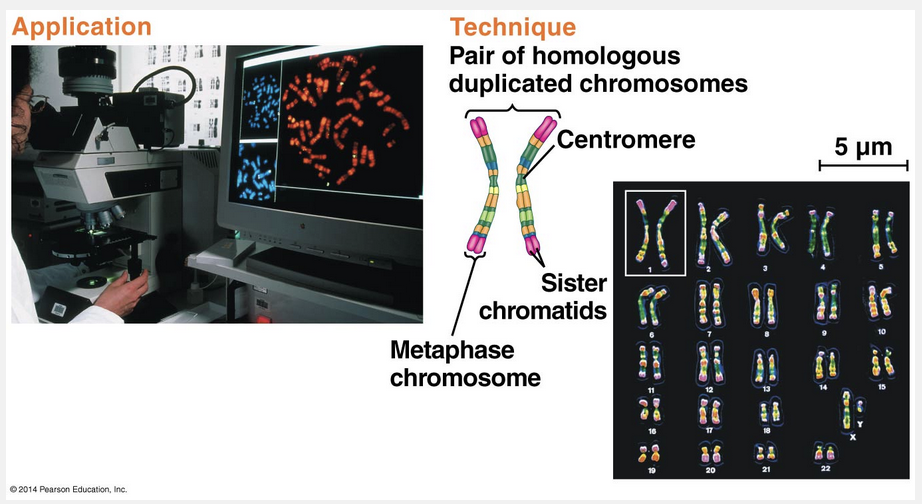
Somatic cells in humans differs from gametes in that human somatic cells __________.
- contain two sets of each of the 23 chromosome types
- do not contain sex chromosomes
- are important in sexual reproduction
- are always haploid
- replicate by a process called meiosis

contain two sets of each of the 23 chromosome types
Ex.
Somatic cells in humans differs from gametes in that human somatic cells contain two sets of each of the 23 chromosome types.
In humans, each somatic cell has 46 chromosomes. During mitosis, the chromosomes become condensed enough to be visible under a light microscope. At this point, they can be distinguished from one another by their size, the positions of their centromeres, and the pattern of colored bands produced by certain chromatin-binding stains. Careful examination of a micrograph of the 46 human chromosomes from a single cell in mitosis reveals that there are two chromosomes of each of 23 types. This becomes clear when images of the chromosomes are arranged in pairs, starting with the longest chromosomes.
The resulting ordered display is called a karyotype. The two chromosomes of a pair have the same length, centromere position, and staining pattern: These are called homologous chromosomes, or homologs. Both chromosomes of each pair carry genes controlling the same inherited characters. For example, if a gene for eye color is situated at a particular locus on a certain chromosome, then the homolog of that chromosome will also have a version of the same gene specifying eye color at the equivalent locus. Unlike somatic cells, gametes contain a single set of chromosomes. Such cells are called haploid cells, and each has a haploid number of chromosomes ( n ). For humans, the haploid number is 23 ( n = 23). The set of 23 consists of the 22 autosomes plus a single sex chromosome. An unfertilized egg contains an X chromosome, but a sperm may contain an X or a Y chromosome.
“Are always haploid” is incorrect because human somatic cells contain two sets of chromosomes and are diploid. “Replicate by a process called meiosis” is incorrect because somatic cells replicate by mitosis. “Are important in sexual reproduction” is incorrect because somatic cells are body cells and not gametes. “Do not contain sex chromosomes” is incorrect because both body cells and gametes have sex chromosomes.
The life cycle called __________ in plants has two multicellular stages: the __________ and the __________.
- germ cell production; haploid gametophyte; diploid sporophyte
- alternation of generations; haploid gametophyte; diploid sporophyte
- alternation of generations; diploid gametophyte; haploid sporophyte
- reduction division; haploid gametophyte; diploid sporophyte
- reduction division; diploid gametophyte; haploid sporophyte
- I don't know yet
Submit
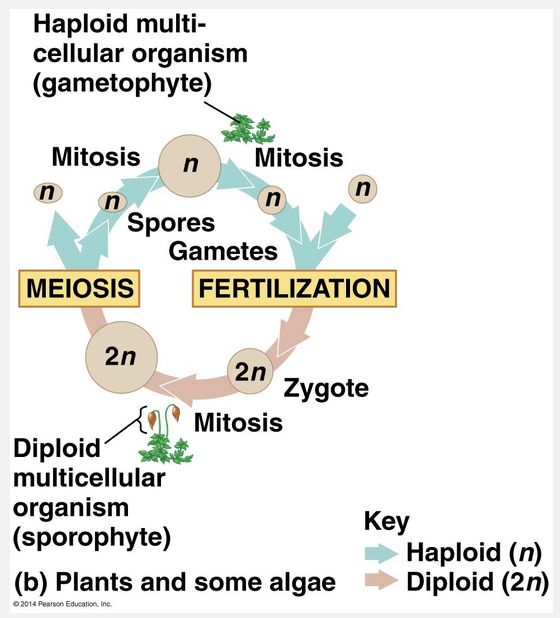
alternation of generations; haploid gametophyte; diploid sporophyte
Ex.
The life cycle called alternation of generations in plants has two multicellular stages: the haploid gametophyte and the diploid sporophyte.
Plants and some species of algae exhibit a second type of life cycle called alternation of generations. This type includes both diploid and haploid stages that are multicellular. The multicellular diploid stage is called the sporophyte. Meiosis in the sporophyte produces haploid cells called spores. Unlike a gamete, a haploid spore doesn’t fuse with another cell but divides mitotically, generating a multicellular haploid stage called the gametophyte. Cells of the gametophyte give rise to gametes by mitosis. Fusion of two haploid gametes at fertilization results in a diploid zygote, which develops into the next sporophyte generation. Therefore, in this type of life cycle, the sporophyte generation produces a gametophyte as its offspring, and the gametophyte generation produces the next sporophyte generation. The term alternation of generations fits well as a name for this type of life cycle.
“Alternation of generations; diploid gametophyte; haploid sporophyte” is incorrect because the gametophyte is always haploid, and the sporophyte is always diploid. “Reduction division; haploid gametophyte; diploid sporophyte” is incorrect because reduction division reduces the number of sets of chromosomes from diploid to haploid. “Reduction division; diploid gametophyte; haploid sporophyte” is incorrect because reduction division reduces the number of sets of chromosomes from diploid to haploid and because the gametophyte is always haploid and the sporophyte is always diploid. “Germ cell production; haploid gametophyte; diploid sporophyte” is incorrect because germ cell production involves meiosis and gamete production.
At the end of mitosis, __________ daughter cells that are genetically __________ are formed, while at the end of meiosis, __________ daughter cells that are genetically __________ are formed.
- two; distinct; four; identical
- two; identical; four; distinct
- two; identical; two; distinct
- four; identical; two; distinct
- four; distinct; two; identical
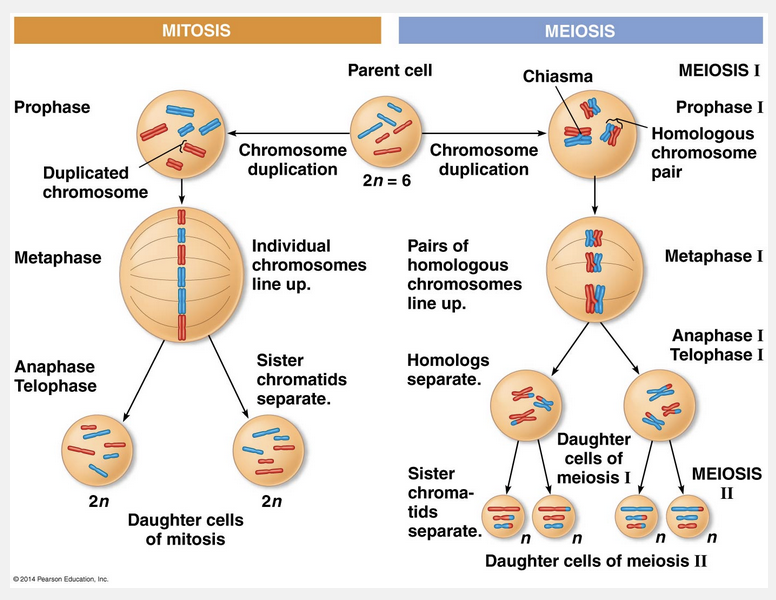
two; identical; four; distinct
Ex.
At the end of mitosis, two daughter cells that are genetically identical are formed, while at the end of meiosis, four daughter cells that are genetically distinct are formed.
The four daughter cells are genetically distinct from one another and from the parent cell at the end of meiosis, while at the end of mitosis, two daughter cells, each genetically identical to the parent cell and with the same number of chromosomes, are produced.
“Four; identical; two; distinct” is incorrect because mitosis produces two daughter cells, and meiosis produces four daughter cells. “Four; distinct; two; identical” is incorrect because mitosis produces two daughter cells that are identical, and meiosis produces four daughter cells that are genetically distinct. “Two; distinct; four; identical” is incorrect because mitosis produces genetically identical cells, while meiosis produces genetically distinct cells. “Two; identical; two; distinct” is incorrect because meiosis always produces four daughter cells.
A life cycle in which the only multicellular form is haploid is most typical of __________.
- protists
- plants
- primates
- fish
- fungi
fungi
Ex.
A life cycle in which the only multicellular form is haploid is most typical of fungi.
Plants and some species of algae exhibit a type of life cycle called alternation of generations. This type includes both diploid and haploid stages that are multicellular. Gametes are produced during the haploid stage. A similar type of life cycle occurs in most fungi and some protists, including some algae. After gametes fuse and form a diploid zygote, meiosis occurs without a multicellular diploid offspring developing. Meiosis produces not gametes but haploid cells that then divide by mitosis and give rise to either unicellular descendants or a haploid multicellular adult organism.
Subsequently, the haploid organism carries out further mitoses, producing the cells that develop into gametes. The only diploid stage found in these species is the single-celled zygote. In most fungi, the multicellular form is haploid, and fertilization (and creation of a zygote) is immediately followed by meiosis. Primates and fish, like all animals, represent a multicellular diploid form. Plants follow the life cycle called "alternation of generations." Many protists are unicellular and do not typically go through an alternation of generations.
Which of the following is a function of mitosis in humans?
- Multiplication of body cells
- Production of eggs
- Increasing genetic variability
- Decreasing the number of chromosomes
- Production of sperm
Multiplication of body cells
Ex.
Multiplication of body cells is a function of mitosis in humans.
Mitosis is the type of cell division that occurs in somatic cells. In this type of cell division, daughter cells have the same number of chromosomes as the parent cell. Somatic cells that go through mitosis are usually diploid. The multiplication of body cells is a primary function of mitosis in humans. Mitosis also enables a multicellular adult to form from a fertilized egg and produces cells for growth and tissue repair. Mitosis keeps the same number of chromosomes, so it does not produce gametes. Mitosis distributes a copy of all of the chromosomes to the two new daughter cells, keeping the chromosome number constant. Mitosis produces two identical copies of the chromosomes, so it does not contribute to genetic variability.
Somatic cells in animals differ from gametes in that somatic cells __________.
- are important in sexual reproduction
- are always haploid
- do not contain sex chromosomes
- are all of the cells of the body except for the gametes and their precursors
- replicate by a process called meiosis

are all of the cells of the body except for the gametes and their precursors
Ex.
Somatic cells in animals differ from gametes in that somatic cells are all of the cells of the body except for the gametes and their precursors.
The transmission of hereditary traits has its molecular basis in the replication of DNA, which produces copies of genes that can be passed from parents to offspring. In animals and plants, reproductive cells called gametes are the vehicles that transmit genes from one generation to the next. During fertilization, male and female gametes (sperm and eggs) unite, passing on genes of both parents to their offspring. Except for small amounts of DNA in mitochondria and chloroplasts, the DNA of a eukaryotic cell is packaged into chromosomes within the nucleus. Every species has a characteristic number of chromosomes. For example, humans have 46 chromosomes in their somatic cells—which include all cells of the body except for the gametes and their precursors. Each chromosome consists of a single long DNA molecule elaborately coiled in association with various proteins. One chromosome includes several hundred to a few thousand genes, each of which is a specific sequence of nucleotides within the DNA molecule. A gene’s specific location along the length of a chromosome is called the gene’s locus (plural, loci; from the Latin, meaning “place”). Our genetic endowment (our genome) consists of the genes and other DNA that make up the chromosomes we inherited from our parents.
“Are always haploid” is incorrect because somatic cells contain two sets and are diploid. “Replicate by a process called meiosis” is incorrect because somatic cells replicate by mitosis. “Are important in sexual reproduction” is incorrect because somatic cells are body cells and not gametes. “Do not contain sex chromosomes” is incorrect because both body cells and gametes have sex chromosomes.
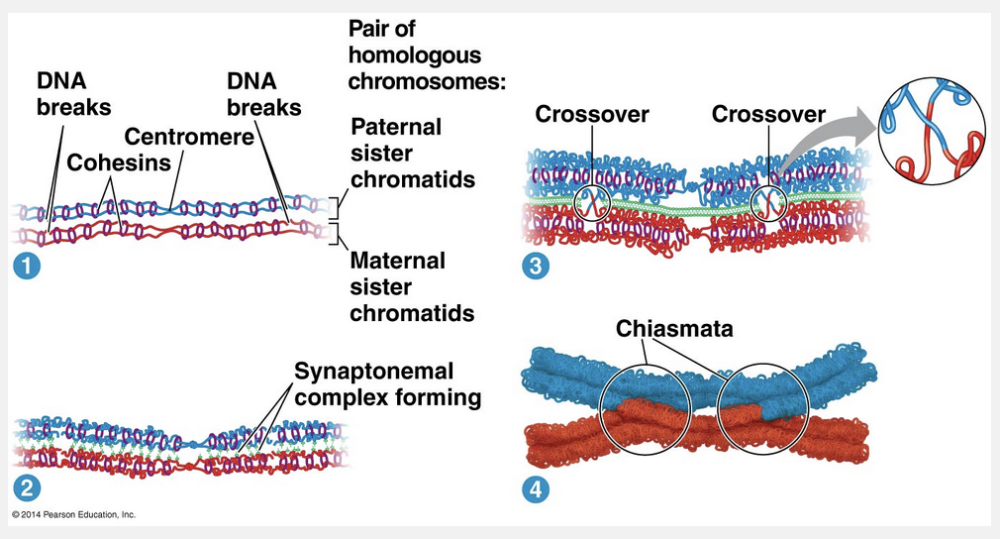
Allelic variation is an important source of __________ in a population.
- None of the listed responses is correct.
- clonal diversity
- genetic diversity
- asexual reproduction
- mitosis
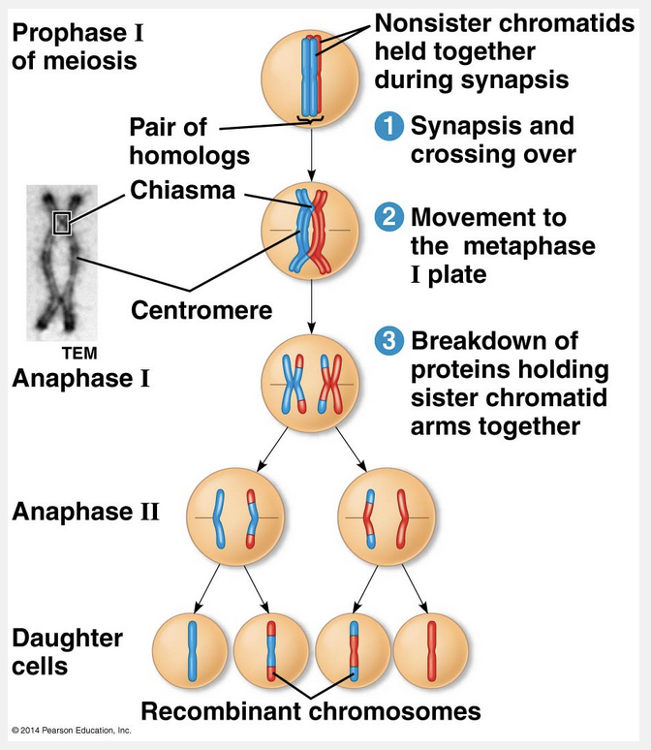
genetic diversity
Ex.
Allelic variation is an important source of genetic diversity in a population.
Mutations are the original source of genetic diversity. These changes in an organism’s DNA create the different versions of genes known as alleles. In meiosis I, crossing over produces chromosomes with new combinations of maternal and paternal alleles. At metaphase II, chromosomes that contain one or more recombinant chromatids can be oriented in two alternative, nonequivalent ways with respect to other chromosomes because their sister chromatids are no longer identical. The different possible arrangements of nonidentical sister chromatids during meiosis II further increase the number of genetic types of daughter cells that can result from meiosis. The important point for now is that crossing over, by combining DNA inherited from two parents into a single chromosome, is an important source of genetic variation in sexual life cycles.
“Clonal diversity” is incorrect because clones are genetically identical cells or individuals with no diversity. “Asexual reproduction” and “mitosis” are incorrect because they produce genetically identical cells or individuals.
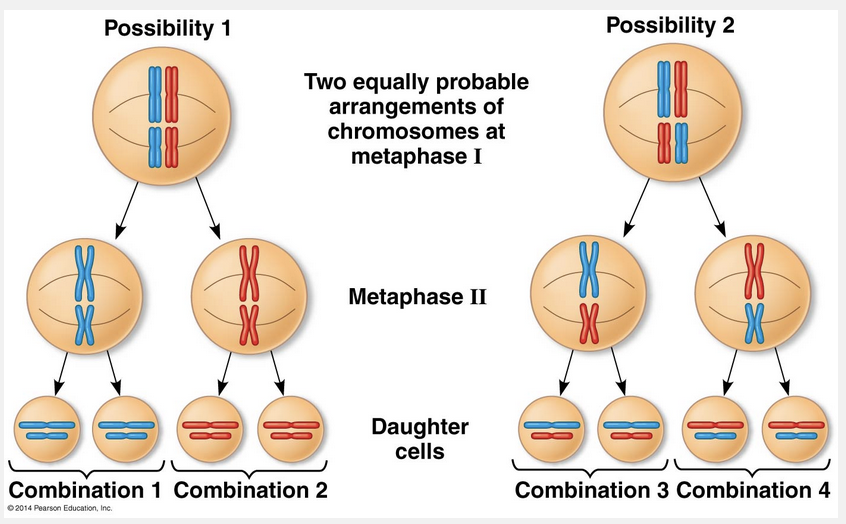
Genetic diversity requires __________.
- sexual reproduction, independent assortment, crossing over between nonsister chromatids of homologous chromosomes, and random fertilization
- asexual reproduction, independent assortment, crossing over between nonsister chromatids of homologous chromosomes, and random fertilization
- asexual reproduction, independent assortment, crossing over between sister chromatids of homologous chromosomes, and random fertilization
- sexual reproduction, nonindependent assortment, crossing over between nonsister chromatids of homologous chromosomes, and random fertilization
- sexual reproduction, independent assortment, crossing over between sister chromatids of homologous chromosomes, and nonrandom fertilization

sexual reproduction, independent assortment, crossing over between nonsister chromatids of homologous chromosomes, and random fertilization
Ex.
Genetic diversity requires: sexual reproduction, independent assortment, crossing over between nonsister chromatids of homologous chromosomes, and random fertilization.
Mutations are the original source of genetic diversity. These changes in an organism’s DNA create the different versions of genes known as alleles. Once these differences arise, reshuffling of the alleles during sexual reproduction produces the variation that results in each member of a sexually reproducing population having a unique combination of traits. In species that reproduce sexually, the behavior of chromosomes during meiosis and fertilization is responsible for most of the variation that arises in each generation. Three mechanisms contribute to the genetic variation arising from sexual reproduction: independent assortment of chromosomes, crossing over, and random fertilization.
“Sexual reproduction, nonindependent assortment, crossing over between nonsister chromatids of homologous chromosomes, and random fertilization” is incorrect because independent assortment is important in obtaining genetic diversity. “Sexual reproduction, independent assortment, crossing over between sister chromatids of homologous chromosomes, and nonrandom fertilization” is incorrect because crossing over between nonsister chromatids of homologous chromosomes as well as random fertilization are important in obtaining genetic diversity. “Asexual reproduction, independent assortment, crossing over between sister chromatids of homologous chromosomes, and random fertilization” is incorrect because sexual reproduction and crossing over between nonsister chromatids are important in obtaining genetic diversity. “Asexual reproduction, independent assortment, crossing over between nonsister chromatids of homologous chromosomes, and random fertilization” is incorrect because sexual reproduction is important in obtaining genetic diversity.
What is the result when a diploid cell undergoes meiosis?
- Two diploid cells
- Four diploid cells
- Four haploid cells
- Two haploid cells and two diploid cells
- Two haploid cells
Four haploid cells
Ex.
Four haploid cells are formed when a diploid cell undergoes meiosis.
Meiosis is preceded by the duplication of chromosomes. However, this single duplication is followed by not one but two consecutive cell divisions, called meiosis I and meiosis II. These two divisions result in four haploid daughter cells each with only half as many chromosomes as the parent cell which are not genetically identical to the diploid parent cell. Two diploid cells would be the result of a diploid cell undergoing mitosis. Four cells are produced, but two of them are not diploid.
A clone is the product of __________.
- asexual reproduction
- meiosis
- sexual reproduction and meiosis
- mitosis
- sexual reproduction
- asexual reproduction and mitosis
asexual reproduction and mitosis
Ex.
A clone is the product of asexual reproduction and mitosis.
Parents endow their offspring with coded information in the form of hereditary units called genes. The transmission of hereditary traits has its molecular basis in the precise replication of DNA, which produces copies of genes that can be passed from parents to offspring. In asexual reproduction, a single individual is the sole parent and passes copies of all its genes to its offspring without the fusion of gametes. An individual that reproduces asexually gives rise to a clone, a group of genetically identical individuals through the process of mitosis. Sexual reproduction produces zygotes, not clones. Meiosis results in gametes, which fuse to produce zygotes during sexual reproduction.
The major contribution of sex to evolution is that __________.
- it provides a method to increase genetic variation and it is the only mechanism for species to reproduce
- it is the only mechanism for species to reproduce
- it provides a method to increase genetic variation
- it is the only mechanism for species to reproduce and it provides a way in which somatic mutations can be inherited
- it provides a way in which somatic mutations can be inherited
it provides a method to increase genetic variation
Ex.
The major contribution of sex to evolution is that it provides a method to increase genetic variation.
Darwin recognized that a population evolves through the differential reproductive success of its variant members. On average, those individuals best suited to the local environment leave the most offspring, thereby transmitting their genes. Thus, natural selection results in the accumulation of genetic variations favored by the environment. As the environment changes, the population may survive if, in each generation, at least some of its members can cope effectively with the new conditions. Mutations are the original source of different alleles, which are then mixed and matched during meiosis. New and different combinations of alleles may work better than those that previously prevailed. The ability of sexual reproduction to generate genetic diversity is one of the most commonly proposed explanations for the evolutionary persistence of this process. Sexual life cycles produce enormous genetic variation among offspring. Because there are asexual organisms, sex is not the only mechanism by which organisms reproduce. Sex does not allow for the inheritance of somatic mutations.
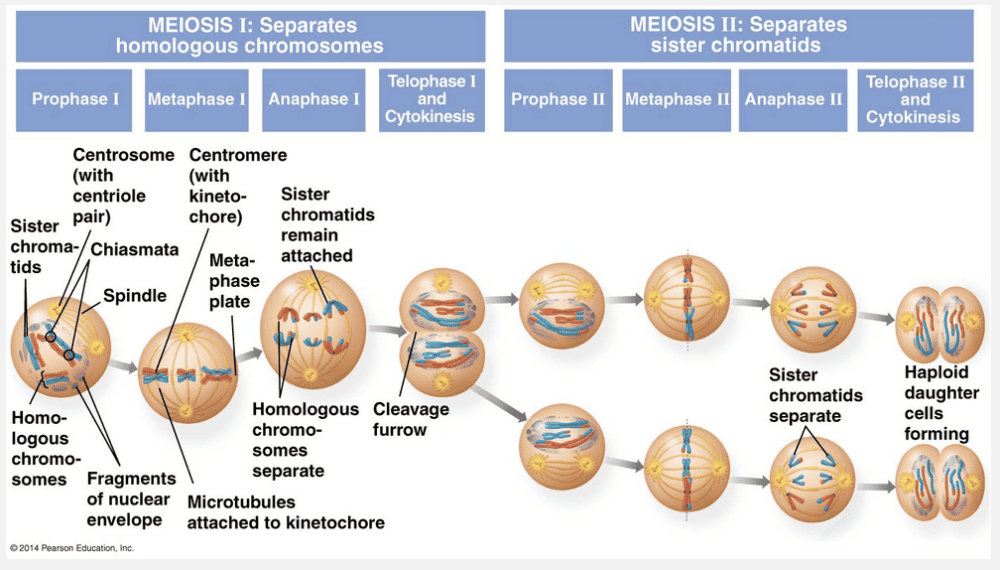
The zipper-like complex that forms in meiosis occurs during __________ and is called the __________.
- metaphase I; synaptonemal complex
- metaphase II; meiotic complex
- prophase I; centromeric complex
- prophase I; synaptonemal complex
- prophase II; meiotic complex
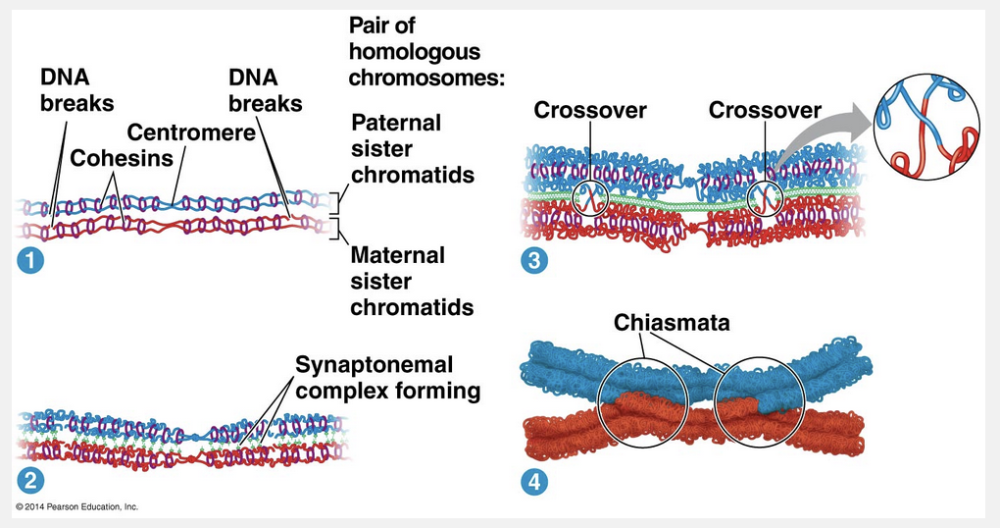
prophase I; synaptonemal complex
Ex.
The zipper-like complex that forms in meiosis occurs during prophase I and is called the synaptonemal complex.
Prophase I of meiosis is a very busy time. The prophase I cell shown in the figure below is at a point fairly late in prophase I, when homologous pairing, crossing over, and chromosome condensation have already taken place.
After interphase, the chromosomes have been duplicated, and the sister chromatids are held together by proteins called cohesins. Early in prophase I, the two members of a homologous pair associate loosely along their lengths. Each gene on one homolog is aligned precisely with the corresponding gene on the other homolog. The DNA of two nonsister chromatids—one maternal and one paternal—is broken by specific proteins at precisely corresponding points. Next, the formation of a zipper-like structure called the synaptonemal complex holds one homolog tightly to the other. During this association, called synapsis, the DNA breaks are closed up so that each broken end is joined to the corresponding segment of the nonsister chromatid. Thus, a paternal chromatid is joined to a piece of maternal chromatid beyond the crossover point, and vice versa. These points of crossing over become visible as chiasmata (singular, chiasma ) after the synaptonemal complex disassembles and the homologs move slightly apart from each other. The homologs remain attached because sister chromatids are still held together by sister chromatid cohesion even though some of the DNA may no longer be attached to its original chromosome. At least one crossover per chromosome must occur in order for the homologous pair to stay together as it moves to the metaphase I plate.
“Metaphase I; synaptonemal complex” is incorrect because the synaptonemal complex forms in prophase I. “Prophase II; meiotic complex,” “metaphase II; meiotic complex,” and “prophase I; centromeric complex” are incorrect because the synaptonemal complex and not the meiotic or centromeric complex forms in prophase I.
A pair of genetic structures carrying genes that control the same inherited characters are called __________.
- autosomes
- sister chromatids
- homologous chromosomes
- zygotes
- nonsister chromatids
- clones

homologous chromosomes
Ex.
A pair of genetic structures carrying genes that control the same inherited characters are called homologous chromosomes.
In humans, each somatic cell has 46 chromosomes. During mitosis, the chromosomes become condensed enough to be visible under a light microscope. At this point, they can be distinguished from one another by their size, the positions of their centromeres, and the pattern of colored bands produced by certain chromatin-binding stains. Careful examination of a micrograph of the 46 human chromosomes from a single cell in mitosis reveals that there are two chromosomes of each of 23 types. This becomes clear when images of the chromosomes are arranged in pairs, starting with the longest chromosomes. The resulting ordered display is called a karyotype. The two chromosomes of a pair have the same length, centromere position, and staining pattern: These are called homologous chromosomes, or homologs. Both chromosomes of each pair carry genes controlling the same inherited characters. For example, if a gene for eye color is situated at a particular locus on a certain chromosome, then the homolog of that chromosome will also have a version of the same gene specifying eye color at the equivalent locus.
“Sister chromatids” is incorrect because sister chromatids are located on the same chromosome. “Nonsister chromatids” is incorrect because nonsister chromatids are located on one of the homologs of each homologous pair. “Autosomes” is incorrect because autosomes are the self-chromosomes of an animal and do not include the sex chromosomes. “Clones” is incorrect because clones are genetically identical individuals. “Zygotes” is incorrect because zygotes are the product of fertilization.
Ignoring crossover, how many kinds of gametes can be produced by an organism with a diploid number of 8?
- 16
- 4
- 8
- 2
- 32
16
Ex.
Ignoring crossover, there are 16 different kinds of gametes that can be produced by an organism with a diploid number of 8.
One aspect of sexual reproduction that generates genetic variation is the random orientation of pairs of homologous chromosomes at metaphase of meiosis I. Each pair may orient with either its maternal or paternal homolog closer to a given pole—its orientation is as random as the flip of a coin. Because each pair of homologous chromosomes is positioned independently of the other pairs at metaphase I, the first meiotic division results in each pair sorting its maternal and paternal homologs into daughter cells independently of every other pair. This is called independent assortment. The number of possible combinations when chromosomes sort independently during meiosis is 2n, where n is the haploid number of the organism. A cell with a diploid number of 8 would have a haploid, or n number, of 4. The possible number of combinations of chromosomes would therefore be 16.
__________ are a group of genetically identical individuals produced by a process called __________.
- Gametes; meiosis
- Clones; asexual reproduction
- Gametes; asexual reproduction
- Clones; sexual reproduction
- Homologs; meiosis
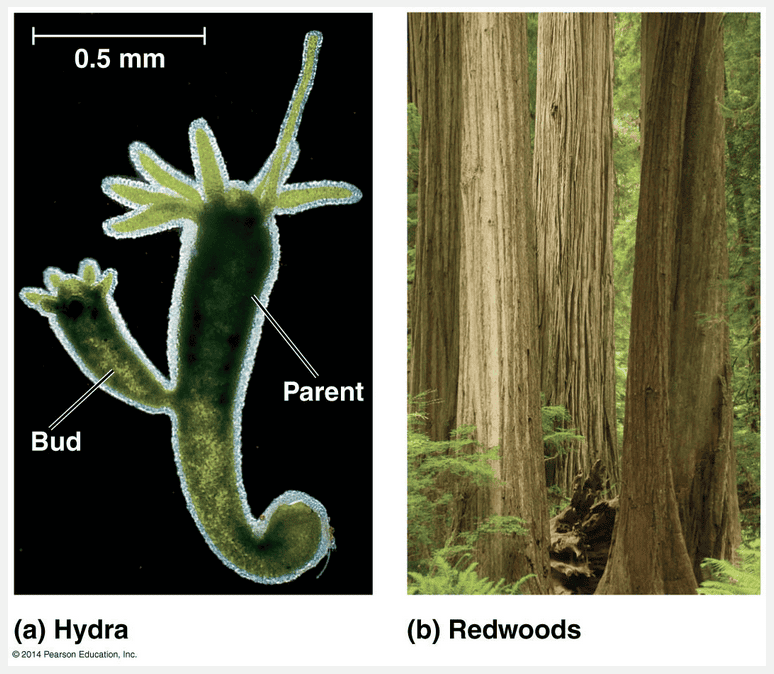
Clones; asexual reproduction
Ex.
Clones are a group of genetically identical individuals produced by a process called asexual reproduction.
Only organisms that reproduce asexually have offspring that are exact genetic copies of themselves. In asexual reproduction, a single individual is the sole parent and passes copies of all its genes to its offspring without the fusion of gametes. For example, single-celled eukaryotic organisms can reproduce asexually by mitotic cell division, in which DNA is copied and allocated equally to two daughter cells. The genomes of the offspring are virtually exact copies of the parent’s genome. Some multicellular organisms are also capable of reproducing asexually. Because the cells of the offspring are derived by mitosis in the parent, the “chip off the old block” is usually genetically identical to its parent. An individual that reproduces asexually gives rise to clones, a group of genetically identical individuals. Genetic differences occasionally arise in asexually reproducing organisms as a result of changes in the DNA called mutations.
“Clones; sexual reproduction” is incorrect because clones are produced by asexual reproduction and not sexual reproduction. “Gametes; meiosis” is incorrect because meiosis produces genetically different gametes and individuals through recombination. “Gametes; asexual reproduction” is incorrect because gametes are produced by meiosis, which produces genetically different gametes and individuals. “Homologs; meiosis” is incorrect because a homolog is part of a pair of chromosomes that exchange information during meiosis and produce genetically different gametes and individuals.
Which life cycle stage is found in plants but not animals?
- Zygote
- Multicellular haploid
- Multicellular diploid
- Unicellular diploid
- Gamete
Multicellular haploid
Ex.
The multicellular haploid stage is found in plants but not animals.
Plants and some species of algae exhibit a type of life cycle called alternation of generations. This type includes both diploid and haploid stages that are multicellular. The multicellular diploid stage is called the sporophyte. Meiosis in the sporophyte produces haploid cells called spores. Unlike a gamete, a haploid spore doesn’t fuse with another cell but divides mitotically, generating a multicellular haploid stage called the gametophyte. Gametes and zygotes are found in all life cycles. Multicellular and unicellular diploid cells are found in animals as well as plants.

Sister chromatids differ from nonsister chromatids in that sister chromatids __________.
- are never found in the paternal set
- always come from nonsister chromatids
- are products of the S phase of the cell cycle and are two copies of one chromosome
- are part of only the maternal set
- are part of nonhomologous chromosomal sets

are products of the S phase of the cell cycle and are two copies of one chromosome
Ex.
Sister chromatids differ from nonsister chromatids in that sister chromatids are products of the S phase of the cell cycle and are two copies of one chromosome.
The overview of meiosis in the figure below shows, for a single pair of homologous chromosomes in a diploid cell, that both members of the pair are duplicated, and the copies are sorted into four haploid daughter cells.
Recall that sister chromatids are two copies of one chromosome, closely associated all along their lengths; this association is called sister chromatid cohesion. Together, the sister chromatids make up one duplicated chromosome. In contrast, the two chromosomes of a homologous pair are individual chromosomes that were inherited from different parents. Homologs appear alike when viewed under a microscope, but they may have different versions of genes, each called an allele, at corresponding loci. Homologs are not associated with each other in any obvious way except during meiosis.
“Always come from nonsister chromatids” and “are part of nonhomologous chromosomal sets” are incorrect because sister chromatids are two copies of one chromosome. “Are part of only the maternal set” and “are never found in the paternal set” are incorrect because sister chromatids are two copies of one chromosome and are formed during chromosomal duplication.
Darwin realized the importance of heritable variation to evolution __________.
- and incorporated Gregor Mendel’s work into his writings without giving Mendel credit for his ideas
- and incorporated Gregor Mendel’s work into his writings
- by studying Gregor Mendel’s work
- None of the listed responses is correct.
- even though he never read any of Gregor Mendel’s work
even though he never read any of Gregor Mendel’s work
Ex.
Darwin realized the importance of heritable variation to evolution even though he never read any of Gregor Mendel’s work.
Sexual reproduction greatly increases the genetic variation present in a population. Although Darwin realized that heritable variation is what makes evolution possible, he could not explain why offspring resemble—but are not identical to—their parents. Ironically, Gregor Mendel, a contemporary of Darwin, published a theory of inheritance that helps explain genetic variation, but his discoveries had no impact on biologists until 1900, more than 15 years after Darwin (1809–1882) and Mendel (1822–1884) had died.
“By studying Gregor Mendel’s work,” “and incorporated Gregor Mendel’s work into his writings,” “and incorporated Gregor Mendel’s work into his writings without giving Mendel credit for his ideas” are incorrect because Darwin never read Mendel’s work.
Characteristic of the bdelloid rotifer is that it __________.
- is fungus-like and therefore haploid
- has never experienced genetic diversity
- produces diploid gametes
- is more plantlike and therefore undergoes alternation of generation
- is an example of an animal that has not reproduced sexually in 40 million years
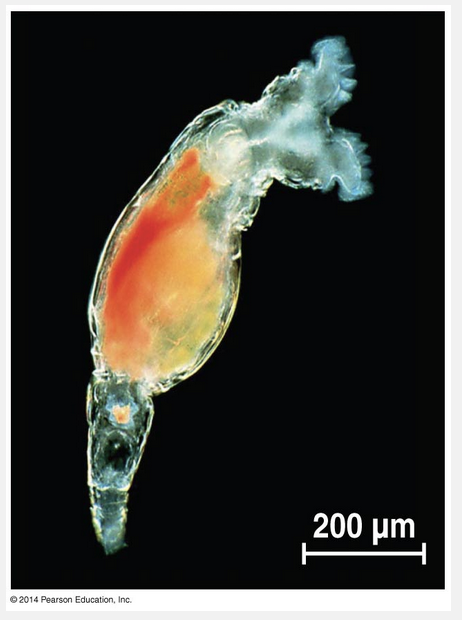
is an example of an animal that has not reproduced sexually in 40 million years
Ex.
Characteristic of the bdelloid rotifer is that it is an example of an animal that has not reproduced sexually in 40 million years.
The ability of sexual reproduction to generate genetic diversity is the most commonly proposed explanation for the evolutionary persistence of this process. Consider the rare case of the bdelloid rotifer. This group has apparently not reproduced sexually throughout the 40 million years of its evolutionary history. Does this mean that genetic diversity is not advantageous to this species? It turns out that bdelloid rotifers are an exception that proves the rule: This group has mechanisms other than sexual reproduction for generating genetic diversity. For example, they live in environments that can dry up for long periods of time, during which they can enter a state of suspended animation. In this state, their cell membranes may crack in places, allowing entry of DNA from other rotifers and even other species. Evidence suggests that this DNA can become incorporated into the genome of the rotifer, leading to increased genetic diversity. This supports the ideas that genetic diversity is advantageous and that sexual reproduction has persisted because it generates such diversity.
“Has never experienced genetic diversity” is incorrect because it has mechanisms other than sexual reproduction for generating genetic diversity. “Is more plantlike and therefore undergoes alternation of generation” is incorrect because animals do not undergo alternation of generation. “Produces diploid gametes” is incorrect because all gametes are haploid and bdelloid rotifers do not reproduce sexually. “Is fungus-like and therefore haploid” is incorrect because bdelloid rotifers are animals and all animals are diploid.
The egg (ovum) of a rabbit contains 22 chromosomes. How many chromosomes are in the somatic (body) cells of a rabbit?
- 44
- 88
- 132
- 11
- 22
44
Ex.
IF the egg (ovum) of a rabbit contains 22 chromosomes. There will be 44 chromosomes in the somatic (body) cells.
Somatic cells are all the cells in the body of an animal except the gametes and their precursors. Somatic cells contain two sets of each chromosome. Any cell with two chromosome sets is called a diploid cell and has a diploid number of chromosomes, abbreviated 2n. In animals and plants, reproductive cells called gametes are the vehicles that transmit genes from one generation to the next. Unlike somatic cells, gametes contain a single set of chromosomes. Such cells are called haploid cells, and each has a haploid number of chromosomes (n). Because the egg of a rabbit contains 22 chromosomes, a somatic cell of a rabbit would contain twice as many chromosomes, for a total of 44.
Regarding the role of cohesin protein in maintaining cohesion between sister chromatids, which of the following statements is false ?
- None of the listed responses is false.
- Cleavage of cohesins between sister chromatid arms at anaphase I allows homologs to separate.
- During meiosis I, cohesion holds sister chromatids together along their lengths as chiasmata form between homologs.
- During meiosis I, cohesion holds sister chromatids together along their lengths as chiasmata form between homologs and during meiosis II, cohesion holds sister chromatids together along their lengths as the second meiotic spindle forms
- During meiosis II, cohesion holds sister chromatids together along their lengths as the second meiotic spindle forms.
During meiosis II, cohesion holds sister chromatids together along their lengths as the second meiotic spindle forms.
Ex.
Regarding the role of cohesin protein in maintaining cohesion between sister chromatids, the following statement is false : During meiosis II, cohesion holds sister chromatids together along their lengths as the second meiotic spindle forms .
Sister chromatids are attached along their lengths by protein complexes called cohesins. In mitosis, this attachment lasts until the end of metaphase, when enzymes cleave the cohesins, freeing the sister chromatids to move to opposite poles of the cell. In meiosis, sister chromatid cohesion is released in two steps, one at the start of anaphase I and one at anaphase II. In metaphase I, homologs are held together by cohesion between sister chromatid arms in regions beyond points of crossing over, where stretches of sister chromatids now belong to different chromosomes. The combination of crossing over and sister chromatid cohesion along the arms results in the formation of a chiasma. Chiasmata hold homologs together as the spindle forms for the first meiotic division. At the onset of anaphase I, the release of cohesion along sister chromatid arms allows homologs to separate. At anaphase II, the release of sister chromatid cohesion at the centromeres allows the sister chromatids to separate. Thus, sister chromatid cohesion and crossing over, acting together, play an essential role in the lining up of chromosomes by homologous pairs at metaphase I.
Unless the chromosomes were stained to show band patterns, a karyotype would be least likely to show which of the following?
- A missing chromosome.
- Part of a chromosome turned around.
- A large part of a chromosome duplicated.
- The attachment of a large part of a chromosome to another chromosome.
- An extra chromosome.
Part of a chromosome turned around.
Ex.
Unless the chromosomes were stained to show band patterns, a karyotype would be least likely to show part of a chromosome turned around .
In humans, each somatic cell has 46 chromosomes. During mitosis, the chromosomes become condensed enough to be visible under a light microscope. At this point, they can be distinguished from one another by their size, the positions of their centromeres, and the pattern of colored bands produced by certain stains. Careful examination of a micrograph of the 46 human chromosomes from a single cell in mitosis reveals that there are two chromosomes of each of 23 types. This becomes clear when images of the chromosomes are arranged in pairs, starting with the longest chromosomes. The resulting ordered display is called a karyotype.
A karyotype is a display of condensed chromosomes arranged in pairs. Karyotyping can be used to screen for defective chromosomes or abnormal numbers of chromosomes associated with certain congenital disorders. An inversion, where part of a chromosome is turned around, affects neither the number of chromosomes nor the length of a chromosome, and is generally difficult to detect without staining to show chromosomal bands. An extra or missing chromosome can be detected by counting the number of chromosomes displayed. By noting the size of the chromosomes, you could see if extra genetic material is present. The attachment of a large part of a chromosome to another chromosome could be detected by looking at chromosomal length.
How many genes are present in the human genome?
- 46
- Hundreds
- 23
- Tens of thousands
- A virtually infinite number
Tens of thousands
Ex.
Tens of thousands genes are present in the human genome.
Parents endow their offspring with coded information in the form of hereditary units called genes. The genes we inherit from our mothers and fathers are our genetic link to our parents, and they account for family resemblances such as shared eye color or freckles. Our genes program the specific traits that emerge as we develop from fertilized eggs into adults. The genome is an organism’s entire complement of DNA, the molecule that carries the genes. Each chromosome has hundreds or thousands of genes; the entire human genome has on the order of 20,000 to 25,000 genes.

In meiosis, __________ of __________ cross over and form __________.
- nonsister chromatids; nonhomologous pairs; chiasmata
- nonhomologs; nonhomologous pairs; cohesion
- nonsister chromatids; homologous pairs; chiasmata
- sister chromatids; nonhomologous pairs; chiasmata
- sister chromatids; homologous pairs; chiasmata

nonsister chromatids; homologous pairs; chiasmata
Ex.
In meiosis, nonsister chromatids of homologous pairs cross over and form chiasmata.
Prophase I of meiosis is a very busy time. The prophase I cell shown in the figure below is at a point fairly late in prophase I, when homologous pairing, crossing over, and chromosome condensation have already taken place.
After interphase, the chromosomes have been duplicated, and the sister chromatids are held together by proteins called cohesins. Early in prophase I, the two members of a homologous pair associate loosely along their lengths. Each gene on one homolog is aligned precisely with the corresponding gene on the other homolog. The DNA of two nonsister chromatids—one maternal and one paternal—is broken by specific proteins at precisely corresponding points. Next, the formation of a zipper-like structure called the synaptonemal complex holds one homolog tightly to the other. During this association, called synapsis, the DNA breaks are closed up so that each broken end is joined to the corresponding segment of the nonsister chromatid. Thus, a paternal chromatid is joined to a piece of maternal chromatid beyond the crossover point, and vice versa. These points of crossing over become visible as chiasmata (singular, chiasma) after the synaptonemal complex disassembles and the homologs move slightly apart from each other. The homologs remain attached because sister chromatids are still held together by sister chromatid cohesion even though some of the DNA may no longer be attached to its original chromosome. At least one crossover per chromosome must occur in order for the homologous pair to stay together as it moves to the metaphase I plate.
“Sister chromatids; homologous pairs; chiasmata,” “nonhomologs; nonhomologous pairs; cohesion,” “nonsister chromatids; nonhomologous pairs; chiasmata,” and “sister chromatids; nonhomologous pairs; chiasmata” are incorrect because in meiosis, nonsister chromatids of homologous pairs cross over and form chiasmata.
Which of the following statements about homologous chromosomes is correct?
- They are found in animal cells but not in plant cells.
- They are found in the cells of human females but not in human males.
- They have genes for the same traits at the same loci.
- They pair up in prophase II.
- They are found in haploid cells.
They have genes for the same traits at the same loci.
Ex.
The following statements about homologous chromosomes is correct: They have genes for the same traits at the same loci.
In humans, each somatic cell has 46 chromosomes. Careful examination of a micrograph of the 46 human chromosomes from a single cell in mitosis reveals that there are two chromosomes of each of 23 types. Homologous chromosomes are pairs of chromosomes that have the same length, among other characteristics. In addition, both chromosomes of each pair carry genes controlling the same inherited characters. For example, if a gene for eye color is situated at a particular locus on a certain chromosome, then the homolog of that chromosome will also have a version of the same gene specifying eye color at the equivalent locus.
Both plant and animal cells contain homologous chromosomes. Cells in prophase II are haploid; homologous chromosomes pair up in prophase I. Haploid cells have only one of each homologous pair. The cells of both males and females contain homologous chromosomes.